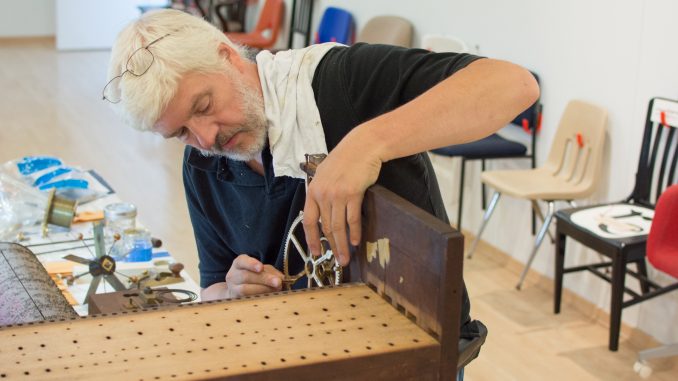
Robert Blackson believes memories aren’t the only way to restore a place in time—it’s the actual objects from that place in time which truly tell a story to remember.
Blackson, director of exhibitions and public programs for Temple Contemporary, works closely with partners like WHYY and the Conservation Center of Art and Historic Artifacts to honor community-based organizations they believe uphold the city’s ideals.
Together, they work toward conserving objects that are emblematic of their personal history and may have been neglected over time.
In 2015 they developed the “Restoring Ideals” project as a mission to connect honorable memories of the past with Philadelphia’s present-day organizations and communities that uphold them.
Blackson said the project began from a question raised by Temple Contemporary’s Advisory Council more than two years ago: “What can we do to sustain the community based organizations of Philadelphia?”
“The way we decided to address that question was to continue making their archives, well, archive-able,” Blackson said.
“These organizations usually aren’t able to think about the history of their organization because of all their events happening every day, so this was an opportunity for them to pause and pull out some of the objects which would have otherwise just been lost in history,” he added.
The Restoring Ideals project is currently working on a live conservation of a historic 19th century flute clock from the Franklin Institute, of which its music hasn’t been heard in more than 100 years.
“We went to the Franklin Institute and asked them what would be an interesting object they would like to see conserved and they chose the flute clock as something valuable and interesting for the people of Philadelphia to recognize as an important object from their history,” Blackson said.

The conservation is taking place now Wednesdays and Fridays in the Temple Contemporary gallery on the ground level of the Tyler School of Art.
Conservation woodworker Scott Kip and horologist Randy Cleaver are working together on the restoration process to bring the clock back to life.
Cleaver already fixed the pendulum in the process to get the clock ticking again while Kip is working on the music mechanism by reconstructing the 100 wooden pipes inside.
When finished, the clock will sit atop an 8-foot tall German chest which holds long weight-driven cables that allow the bellows to provide air and winds to play the pipes.
Kip said the cylinder inside has pins that record and play different musical pitches. The tunes are played manually by winding a crank that causes the clock to trigger the barrel organ and play music through the pipes.
“It’s mechanically recorded music, sort of like a music box—a very old music box,” Kip said.
Kip figured out there’s about nine different songs recorded on the barrel and he said if time allows, he would like to try and create his own pitches of music within the pipe organs.
“There’s five cylinders with, I think, about nine tunes on each one, so I’d like to maybe make a few reproduction cylinders and put my own tunes in to make it play something else,” Kip said.
The date for the finished product is estimated to be January 2016.
Blackson said Temple Contemporary has worked with a range of other objects through their collaborations with local organizations, accumulating many artifacts important to the community.
“We were able to get some of the very first issues from The Public School Notebook and restore those,” Blackson said.
“There was also great things from other organizations such as the Attic Youth Center,” he added. “We got the first flag they flew as part of an [LGBT] adolescents’ march for coming out. It’s just been such a beautiful range of objects that we’ve conserved here in the gallery space at Temple Contemporary.”
Alexa Zizzi can be reached at alexa.zizzi@temple.edu.


Be the first to comment